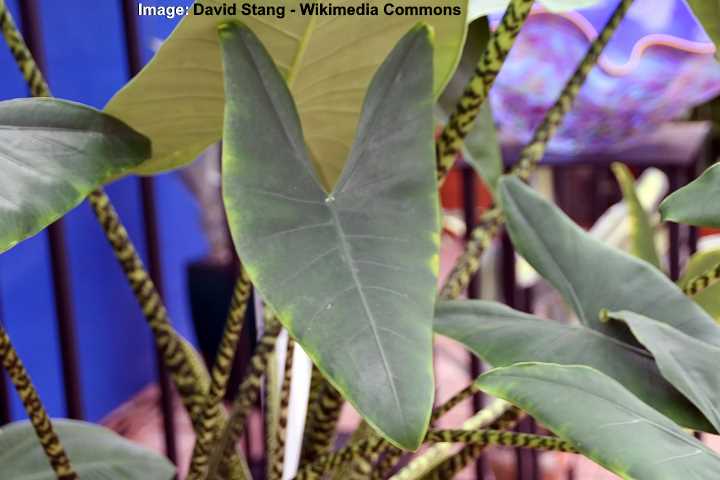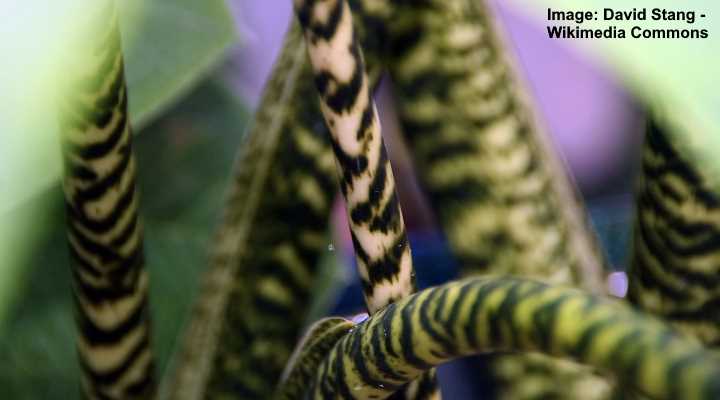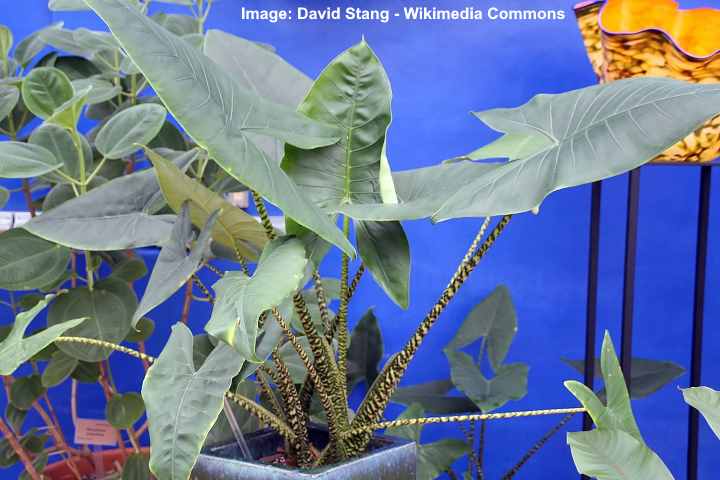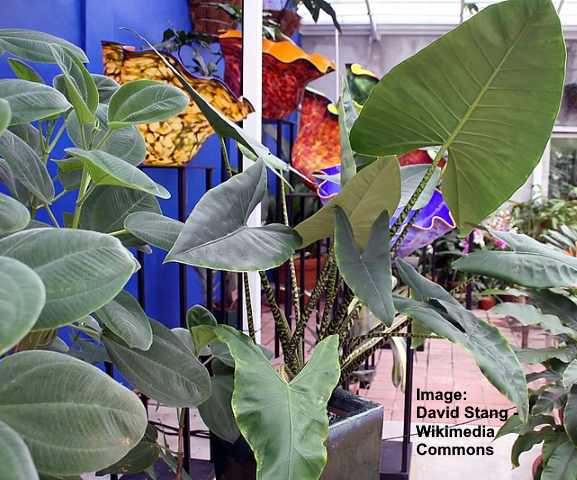Alocasia Zebrina: Plant Care and Growing Guide (With Pictures)

Alocasia zebrina is a stunning tropical evergreen perennial houseplant with large glossy green arrowhead leaves and stems with zebra-like patterns. Also called the Alocasia zebrina Tiger or Alocasia Leopard, this plant has long arching spotted stalks with unusual patterns. As with all species of Alocasia, the zebrina variety has triangular-shaped leaves that grow quickly.
Alocasia zebrina is a fascinating species of houseplant. However, they are not the easiest plants to grow indoors. Species of Alocasia can drop some leaves, and they need warm, humid conditions to thrive. However, if you care for an Alocasia zebrina plant well, it will reward you with stunning foliage.
This article is a complete care and growing guide for the Alocasia zebrina houseplant. At the end of the article, you’ll find out how to resolve some issues with growing ‘zebra’ plants indoors.
How to Care for Alocasia Zebrina
Alocasia zebrina houseplants grow best in loose, well-draining potting soil and a bright location, protected from direct sunlight. The zebrina cultivar thrives in temperatures between 60°F and 82°F (15°C – 28°C) with humidity over 60 percent. Water the Alocasia zebrina when the top 0.5” (1 cm) of soil is dry and fertilize twice a month during the growing season.
Alocasia Zebrina Facts

Alocasia zebrina (Alocasia zebrina Tiger or Alocasia Leopard) is famous for its unusual patterned stalks which have a ‘zebra’ or ‘leopard’ look
Alocasia zebrina plants are a member of the family Araceae and are native to tropical climates. There are 79 species of Alocasia, with Alocasia amazonica ‘Polly’ and Alocasia zebrina being the most popular. Most species of Alocasia—including zebrina—are famed for their large arrow-shaped leaves.
Some common names of Alocasia zebrina are Alocasia zebrina ‘Tiger,’ ‘Elephant Ear,’ Alocasia reticulata zebrina, Alocasia ‘Leopard,’ and Zebra Alocasia. Some of these names, such as ‘Elephant Ear,’ are applied to several species of Alocasia plants.
The many names for Alocasia zebrina are related to its unusual stalks. The animal-print stems are dark green with blotches of light green or cream in random patterns. This characteristic feature gives the Alocasia plant stems a ‘zebra’ or ‘leopard’ look. If you’re looking for an unusual type of houseplant, then the Elephant Ear ‘Tiger’ is an excellent choice.
Alocasia zebrina quickly grows up to 3 ft. (1 m) tall when growing in the right conditions.
This tropical plant is also a flowering species of plant. Alocasia zebrina produces flowers that look like calla lilies or peace lilies. However, Alocasia zebrina is kept for its stunning zebra-patterned stems and arrow leaves, not its flowers.
Alocasia Zebrina Flowers
Zebra Alocasia flowers are made up of a spathe and spadix, similar to all species of aroids. Alocasia zebrina has a spadix that is covered in tiny whitish-green flowers. A leaf-like spathe partly covers this flowering spike. However, Alocasia zebrina flowers are insignificant, and the plant rarely blooms indoors.
Alocasia Zebrina Growth Rate
Alocasia reticulata zebrina is a fast-growing tropical plant in the right conditions. You can expect the plant to produce leaves every week or two in warm, bright light, and moist soil. Old foliage dies off and is replaced with new, arrowhead leaves.
Alocasia Zebrina Care Guide
Let’s look in more detail at how to get conditions right for growing Elephant Ear ‘Tiger’ plants at home. You’ll also find out how to propagate, prune, and repot these tropical houseplants.
Alocasia Zebrina Tiger Light Requirements

To care properly for your Alocasia zebrina houseplant, give it plenty of indirect sunlight
Alocasia zebrina plants need plenty of bright light but protected from direct sunlight. In their native habitat, Zebra Alocasia grows on the tropical forest floor in dappled light. The best location to grow your ‘tiger’ plant is near a bright east- or west-facing window. If the Alocasia plant is at a south-facing window, protect it from sunlight behind a sheer curtain.
Zebrinas large arrow-shaped leaves are excellent for absorbing sunlight. However, direct sunlight will scorch the dark green leaves and may turn them yellow. If you notice some yellowing in the leaves, move the plant out of direct light.
Although Alocasia zebrina grows in a jungle environment, they are not plants that survive without sunlight. ‘Tiger’ plants can survive in shaded environments, but they won’t grow fast. In some cases, the large, beautiful plant leaves will lose their color, and then the tropical plant can eventually die.
Top care tip for growing Alocasia zebrina: When growing in a bright room, rotate the plant by 90° every so often to encourage uniform, even foliage growth.
The Best Soil for Zebra Alocasia
Alocasia zebrina thrives in a loose potting soil that drains fast. The best soil mix for Alocasia plants is one part peat moss, one part regular houseplant soil, and one part perlite or coarse sand. This type of potting mix is light, airy and fertile, and doesn’t hold excess moisture.
Elephant Ear ‘Tiger’ plants need moist soil, without being too soggy or damp. The thick rhizome root of Alocasia plants rots easily in waterlogged soil. If root rot starts, the plant will become droopy, the leaves will turn yellow, and eventually die.
The goal of creating your own houseplant soil mix is to ensure that it holds some moisture without staying too damp for too long. For example, peat moss is ideal for potted plants as it contains nutrients and is a loose growing medium. Amendments to the soil such as charcoal bits, coarse sand, poultry grit, or perlite improve drainage.
Of course, you also need the right type of pot for growing Alocasia zebrina houseplants. So, make sure there is at least one drainage hole in the pot’s base. Also, remember that soil moisture in terracotta pots evaporates faster than plastic pots. This factor can affect how often you need to water your Tiger Alocasia.
How to Water Alocasia Zebrina Plants

Water Alocasia Zebrina plants frequently in small amounts to keep the soil moist. This helps to reduce the risk of root rot.
Alocasia zebrina plants need watering as often as the top layer of soil dries. To water a ‘Tiger’ plant, you should water it frequently in small amounts to keep the soil moist. Wait until the top 0.5” (1 cm) of potting soil is dry before watering it again. The goal of watering is to ensure the soil is never too damp or too dry.
Watering Alocasia zebrina plants is different from watering regular houseplants. Usually, it’s best to water most houseplants with the drench and dry method. However, with Elephant Ear ‘Tiger’ plants, it’s best to water a little and often. This is the best way to avoid roots rotting in the soil.
It’s also important to remember that potting soil can dry out at different rates depending on the season, type of pot, climate, and plant size.
Alocasia zebrina plants have a period of winter dormancy. During this time, they will have minimal watering needs. So, you should water less in winter and make sure that at least 2” (5 cm) of the potting soil is dry before watering.
Top care tip for watering Alocasia zebrina plants: Don’t follow a set schedule to water your ‘Tiger’ plant. Check for soil dryness before giving the plant a little drink.
Temperature Requirements to Grow Alocasia Zebrina Houseplants
Alocasia zebrina plants grow best in warm temperatures. The ideal temperature range for Tiger Alocasia is between 64°F and 82°F (18°C – 28°C). This tropical plant species is especially susceptible to cold chills. If the plant is growing in temperatures below 60°F (15°C), you’re likely to experience some leaf drop.
Alocasia zebrina generally likes average room temperature.
Here are a few care tips when growing Tiger Alocasia as a houseplant:
- Avoid sudden room temperature fluctuations to ensure healthy growth.
- Don’t place Alocasia pots in a cold draft or air-conditioning airflow.
- Don’t grow ‘Tiger’ plants too close to a hot radiator.
If you live in warm, tropical climates, Alocasia zebrina plants will grow outdoors. Their USDA growing zone is 10 or 11.
You can take a potted zebrina plant outside on your balcony, patio, or deck area during warm summers. Put the pot in a bright location where there’s dappled sunlight. It’s vital to protect the Alocasia plant from the hot midday sun. When temperatures drop below 64°F (18°C), take the plant back indoors.
Humidity Needs for Alocasia Zebrina Indoor Plants

Alocasia zebrina needs high humidity levels and will benefit from regular misting
Alocasia zebrina plants need high humidity for the best growth. Native to rainforests, Alocasia zebrina requires plenty of moisture in the air to thrive. Average household air tends to be too dry for Elephant Ear Tiger plants. So, you will have to mist the Alocasia zebrina leaves daily to ensure adequate moisture levels.
Of course, misting plant leaves daily is a time-consuming task. Here are two other ideas to raise indoor humidity for your tropical houseplants:
- Room humidifier—If you grow many plants indoors, a humidifier can help to make sure there’s enough moisture in the air.
- Humidity tray—Put a layer of pebbles in a tray or large saucer and fill with water until it’s half-way up the stones.
Top care tip for growing Alocasia zebrina indoors: Winter heating can quickly cause dry air, so pay special attention to humidity levels during winter.
The Best Fertilizer for Growing Alocasia Zebrina
Fast-growing Alocasia zebrina plants need extra fertilization during the growing season. Use a regular balanced houseplant fertilizer diluted to half strength. Fertilize the Alocasia plant every two weeks to encourage new leaf growth. Under ideal conditions, Alocasia zebrina can grow one or two fresh leaves a month.
It’s best to remember that Alocasia zebrina houseplants are sensitive to over-fertilization. So, you could use an organic, natural houseplant fertilizer. Ingredients such as sea kelp, plant extracts, or tea compost give plants the nutrients they require. But because there are no chemicals, there is little risk of mineral root burn from over-fertilization.
How to Repot Zebra Alocasia Indoor Plants
Alocasia zebrina plants don’t require repotting often. The plant grows well being slightly rootbound, and repotting can stress the plant’s delicate roots too much. If you need to transfer the plant to a larger pot, choose a pot the next size up from its current one. And, always repot in spring.
The best time to repot a Zebra Alocasia is when the roots are poking out the bottom. Repotting gives you a chance to check for root damage, refresh the potting soil, and encourage healthy growth. However, you may find that your plant takes a few weeks to adjust to its new pot.
Pruning Alocasia Zebrina
The only reason to prune an Alocasia zebrina plant is to remove dead or dying leaves. The Tiger Alocasia is naturally a large plant, and you can’t make it grow shorter or bushier through pruning.
Propagating Alocasia Reticulata Zebrina

The best way to propagate Alocasia zebrina plants is by root division
Like all species of Alocasia, the ‘Tiger’ plant has tuberous roots that you can separate for propagation. This plant also grows offsets—smaller plants growing at the base—that you can remove and repot in a new container. It’s always best to propagate houseplants in the spring.
To propagate Alocasia zebrina, gently remove the mother plant from its container. Remove the loose dirt and look for small offsets growing near the base. Use a sterilized knife to cut the small new clumps carefully from the main plant. Replant the plantlets in soil, and repot the mother plant in fresh potting soil.
Pests that Affect Alocasia Zebrina Plant Growth
Spider mites and mealybugs are the most common pests affecting Alocasia zebrina plants. Use a homemade neem oil insecticide to get rid of any houseplant pests. In a spray bottle, combine 1 quart (1 l) of warm water, 2 tsp. organic neem oil, and 1 tsp. liquid dish soap. Shake well and liberally spray the natural insecticide on the foliage to get rid of bugs. Repeat once a week for the best results.
The good news is that healthy, well-cared-for Alocasia zebrina plants are generally resistant to houseplant infestations.
Related reading: How to identify houseplant bugs and get rid of them fast.
Disease Affecting Alocasia Zebrina Tiger Plants
Root rot and leaf-spot are common diseases to affect Tiger Alocasias. Typically, these plant diseases are avoidable because they are caused by overwatering. The best way to keep Alocasia plants healthy is to water them appropriately.
Here are a few handy tips to avoid diseases in Alocasia zebrina plants:
- Only water Alocasia zebrinas when the top 0.5” (1 cm) is dry and give enough water to hydrate the roots.
- Keep the tropical houseplant where there is good air circulation.
- Make sure that the soil is loose and well-draining.
Are Alocasia Zebrina Plants Toxic?
Alocasia zebrina Tiger plants can poison cats and dogs if they ingest the leaves or spotted stems. The ASPCA reports that Elephant’s Ear plants contain calcium oxalates. These toxins can cause oral swelling, pain, and irritation, as well as excessive drooling and vomiting.
All parts of Alocasia plants are poisonous for humans.
FAQs About Alocasia Zebrina Care
Why are my Alocasia Zebrina leaves drooping?
Drooping arrowhead leaves are usually a sign that your Alocasia zebrina needs water. So, check the soil for dryness and water if necessary. It may be required to water frequently until the plant absorbs enough moisture to grow strong again.
Other reasons for drooping Alocasia leaves are insufficient light, cold drafts, dormancy, or inadequate humidity.
My Alocasia Zebrina leaves are turning yellow, what’s wrong?
There are several reasons why Alocasia zebrina plants get yellow leaves. One reason is too much direct sunlight. However, overwatering can cause leaves to be yellow if roots have started to decay.
Another reason for Alocasia zebrina leaves turning yellow is a lack of nutrients. Usually, one plant can sustain four or five leaves. If you have more leaves, prune the older ones to concentrate growth in the newer leaves. However, Alocasia zebrina plants generally shed older leaves as new ones appear.
Why do drops of water appear on Alocasia Zebrina plant leaves?
Don’t worry about noticing a drop of water on the leaf tips. This type of “sweating” could indicate that there is slightly too much moisture in the soil. Hold off watering until the top part of the soil is dry before watering.
Why are my Alocasia Zebrina leaves turning brown?
A lack of humidity usually turns Zebra Alocasia leaves brown. If you notice brown leaf patches or brown leaves, then mist the plant regularly to increase humidity. However, if the plant is in dormancy, some foliage usually dies off before regrowing the following spring.
Related articles:
